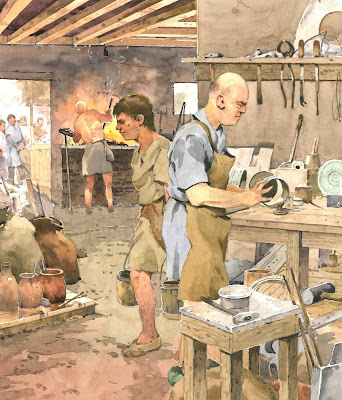Even many hundreds of years before the Industrial Revolution, Castleford was an important manufacturing centre.
In this blog, we explore the many things Made in Castleford by the Romans!
Made for the military
Roman Castleford began in about 71 AD as a fort built as part of the violent invasion and conquest of northern England. A garrison of 600 soldiers was based in the fort and very quickly their money attracted local traders. This usually happened at Roman forts - a small settlement grew up nearby that provided the troops with food, drink, entertainment and so on.
When the civilian area outside the Castleford fort was excavated, it revealed a number of hearths, lots of remains from smelting, and bits of military kit. This clearly suggests that there were workshops making and repairing equipment for soldiers. They would certainly have been doing this for the local garrison but maybe also for the army supply network more widely.
Flourishing after the fort
These workshops were probably why the town continued to thrive after the fort was abandoned around 100 AD. It was perfectly normal for the Roman army to build forts and then demolish them when the area around was pacified and a large occupying garrison was no longer needed. But when this happened, the settlements alongside the forts usually disappeared too, as there was no more need for their shops and services.
Castleford is unusual because, when the fort was vacated, the town continued to prosper and even flourish. Wooden buildings were replaced with stone ones and expensive statues were placed in the town. Part of this success may have come from its handy location; it was a port trading with the wider Empire including the Mediterranean, and a convenient stop on the main road between London and York. But it was also an important manufacturing centre.
Mass production
 |
| Fragments of spoon moulds found in Castleford |
One specialist industry in Roman Castleford was spoon-making. Hundreds of bits of moulds made from local clay have been found. These moulds would have been bundled together so that up to 16 spoons could be made at once by pouring molten bronze into them. Once the metal had cooled, the clay moulds were broken open to get at the spoons, and the broken pieces of the moulds thrown away. Castleford is the only place in Britain where this kind of complex mould has been found, and the only spoon-making centre in the Western Roman Empire.
Castleford was also a centre for making enamelled metal objects, often objects connected to the army. The bronze objects were cast in distinctive clay moulds which left depressions in the metal. These depressions were then filled with a special paste which turned into a glassy enamel when heated. The things made were a fusion of Roman metalwork with British decoration, producing a striking, colourful look.
Souvenir shopping
 |
| Bronze fibula brooch |
This half-finished brooch found by archaeologists gives us evidence about some of the objects made in Castleford. For the Romans brooches were functional, used by everyone, including soldiers, to fasten clothing before buttons and zips were invented. But brooches were also decorative and some were even souvenirs. The bright colours of the enamel would have been very striking. Another brooch found recently in Lincolnshire had an inscription on it saying it came from Lagentium, the Roman name for Castleford.
The Romans liked these sort of souvenirs, and we know of some unusual cups and bowls with the names of forts on Hadrian’s Wall on them. One example found recently was the Staffordshire Moorlands Pan.
 |
| Portable Antiquities Scheme from London, England / source https://commons.wikimedia.org/wiki/File:Staffordshire_Moorlands_Pan_(1284837406).jpg |
Interestingly these too are enamelled metal objects - were they made in Castleford? We know the Romans were definitely making similar things in Castleford because, as well as spoon moulds, the moulds for elaborate enamelled bronze water flasks have also been found. You can see a complete flask of this type in a museum in Vienna. It’s fascinating to think that products made in Roman Castleford may have travelled to the continent.
If you have enjoyed finding out about Roman Castleford's manufacturing heritage, why not have a go at recreating the fabrica scene in our digital jigsaw below?


No comments:
Post a Comment
We would love your comments - though they may take a day or two to appear.